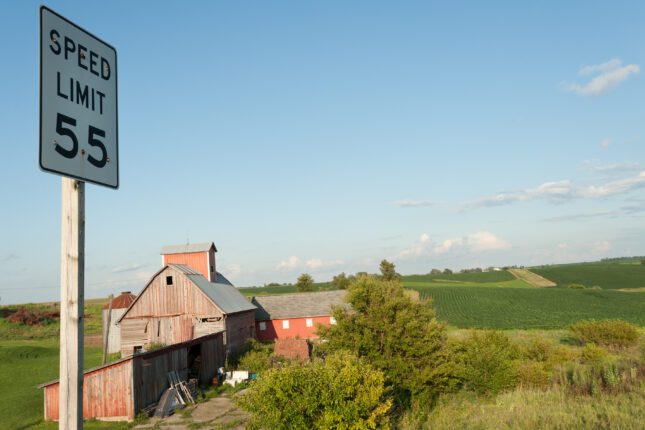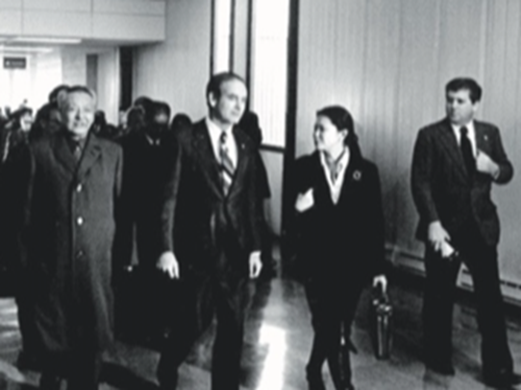-
A Commune in Rural Iowa Inspires Reform in China’s Countryside
January 18, 2024 By Karen ManclA quiet agricultural community in east, central Iowa is a surprising place to learn about the evolution of communes in the United States. While a graduate student at Iowa State University, I first visited the Amana Colonies in 1979. The brick homes, the woolen mill, and the community kitchens were first built in 1855 by a group of German immigrants, forming the now oldest commune in the country.
A year after my first visit to the Amana Colonies, a group of Chinese governors came to Iowa on an official agricultural tour which included visits to a family farm, a seed company, a food plant, and Iowa State University Seed Science Center. Their long day ended with a dinner stop to experience some German food at an Amana restaurant. Surprisingly, it was a short lecture on the history of the Amana Colonies that turned out to be the highlight of the trip. The Governor of Guangdong Province was fascinated by the story of how the agricultural commune turned into a profit-sharing company with individual household shareholders. His name was Xi Zhongxun, the father of the current Chinese President, Xi Jinping.
The Amana visit provided Xi Zhongxun with a roadmap on how to decentralize agricultural decision-making, increase food production, and build a market economy from collective farms. He supported such reforms a year later, which helped bring millions of farmers out of poverty and increase food security. This is an example of how US-China agricultural exchange programs had unexpected, positive impacts extending well beyond the food production technical agenda.
Guangdong Governor Xi Zhongxun and Iowa Governor Ray on a 1980 exchange visit in Iowa. Ken Quinn (far right) escorted Governor Xi on the visit
Communal Agriculture in Rural Iowa
The evolution of agriculture in the Amana villages was different from the majority of rural America, where land is privately owned. In the 1800s, residents in the Amana villages shared everything – farmland, businesses, homes, health care, food, household necessities and schooling for their children. First founded in 1855 on 26,000 acres of fertile Iowa farmland, the religious commune grew to over 1,800 residents.
In 1932, during the Great Depression, residents wanted more control and flexibility as they were facing hard economic times. Through a simple vote, the community underwent what they called the “Great Change.” The commune was reorganized, without force, favor, or propaganda, into the secular Amana Society, a joint stock company of 61 different small businesses. While 80 percent of the community capital was invested in farms, only 40 percent of the residents worked as farmers. The others worked in the community mill and stores and even the new Amana refrigerator factory.
Chinese Farmers Changing China
From the 1950s to the 1970s, Chinese farmers had been living in communes as part of a production team. All farmland was managed by the local government and all the village residents were assigned tasks to accumulate work points. After the government share and taxes were taken out of the harvest, the remaining money was divided based on work points. Mao Zedong launched this communal system, which at first seemed fair, but suffered from low productivity as the workers lacked control and motivation.
Floods, droughts and the disastrous “Great Leap Forward” famine pushed farmers to start retaking control of farming decisions. While starting most notably with the agricultural production teams in Anhui Province in the late 1970s, the roots of this movement began throughout China in the 1960s as a spontaneous, unorganized, leaderless, and nonideological movement as Kate Xiao Zhou described in her book “How the Farmers Changed China.”
Despite these grassroots farmer initiatives to decentralize farming decisions, leaders in Beijing continued to exercise top-down control of agricultural production.The 4th Plenary Session of the 11th Central Committee prohibited the adoption of the household responsibility system in September of 1979.
But change was coming.
Ag Exchanges Catalyzing Change
Deng Xiaoping opened up China to the world and worked to improve US-China relations, which made the first agricultural exchanges possible. A group of US Governors, including Iowa’s Robert Ray, visited China in 1979 and Xi Zhongxun’s group of Chinese Governors visited urban and rural areas in the United States in the following year.
The Chinese Governors’ time in Iowa stood out. Ambassador Ken Quinn, who participated in the US-China governor exchanges in both 1979 and 1980, described his impressions of Xi Zhongxun’s visit. Quinn told me in an interview how surprised he was when “Governor Xi asked more questions about the Amana Colonies than all of the other stops combined.” At the time, Quinn thought it was just a quirky interest in history, but he later saw how China took a similar path moving to reform the countryside dividing the communal land up into small farms with individual household responsibility.
In his position as the vice-chairman of the Standing Committee of the National Peoples’ Congress, in late 1981, Xi Zhongxun and other Chinese leaders drastically changed the way farmland was managed by approving the Household Responsibility System. In this system, the local government still owns the land, but the families have the responsibility and can make their own decisions on how to farm it. Within two years, the entire Chinese countryside had dissolved the communes and the farmers were then responsible for their own plots of land.
In 1980, without the Internet it was impossible for a farmer or a government official to research examples of success on how to reform the agricultural commune system. But Xi Zhongxun found an inspiring model for rural reform during his agricultural exchange in Iowa.
It was five years later in 1985, that Xi Jinping, as a county official in Hebei Province, had an opportunity like his father to come to Iowa on an agricultural exchange. This visit had such a profound impact on him that Xi Jinping later asked Iowa Governor Branstad to help him arrange a return trip to Iowa in 2012 as he was ascending to Chinese leadership. That trip planted the seed for the creation of the US-China Friendship Demonstration Farm, an Iowa style farm in rural China.
In response to growing political tensions, US-China exchanges started to stall in 2018. One of the last agricultural exchanges focused on food and climate, an area that is ripe for bilateral cooperation today. While it is a quiet form of science diplomacy, agricultural exchanges have had an outsized positive impact on farmers, scientists, and policymakers. Perhaps it is time they are restarted.
This article is part of a Wilson Center-Ohio State University Cultivating US and Chinese Climate Leadership on Food and Agriculture project.
Karen Mancl is a Wilson Center Fellow studying US-China agricultural collaboration and retired Professor of Food, Agricultural and Biological Engineering at The Ohio State University, She holds a PhD in Water Resources from Iowa State University, an MA in East Asian Studies and an MA in Public Policy from Ohio State University.
Sources: Amana, Amana Society Bulletin, Asian Studies, ChinaCulture.org, China Daily, Communal Societies, Des Moines Register, Iowa PBS, Iowa Sister States, National People’s Congress of the PRC, State Historical Society of Iowa, University of Chicago Press, US Heartland China Association, VCU, Wall Street Journal, Westview Press
Header Photo Credit: Red farm in historic Amana colonies in east-central Iowa state, USA. Courtesy of Natalia Bratslavsky/Shutterstock.com
Second Photo Credit: Guangdong Governor Xi Zhongxun and Iowa Governor Ray on a 1980 exchange visit in Iowa. Ken Quinn (far right) escorted Governor Xi on the visit. Photo courtesy of Ambassador Ken Quinn, President Emeritus World Food Prize.
 A Publication of the Stimson Center.
A Publication of the Stimson Center.









